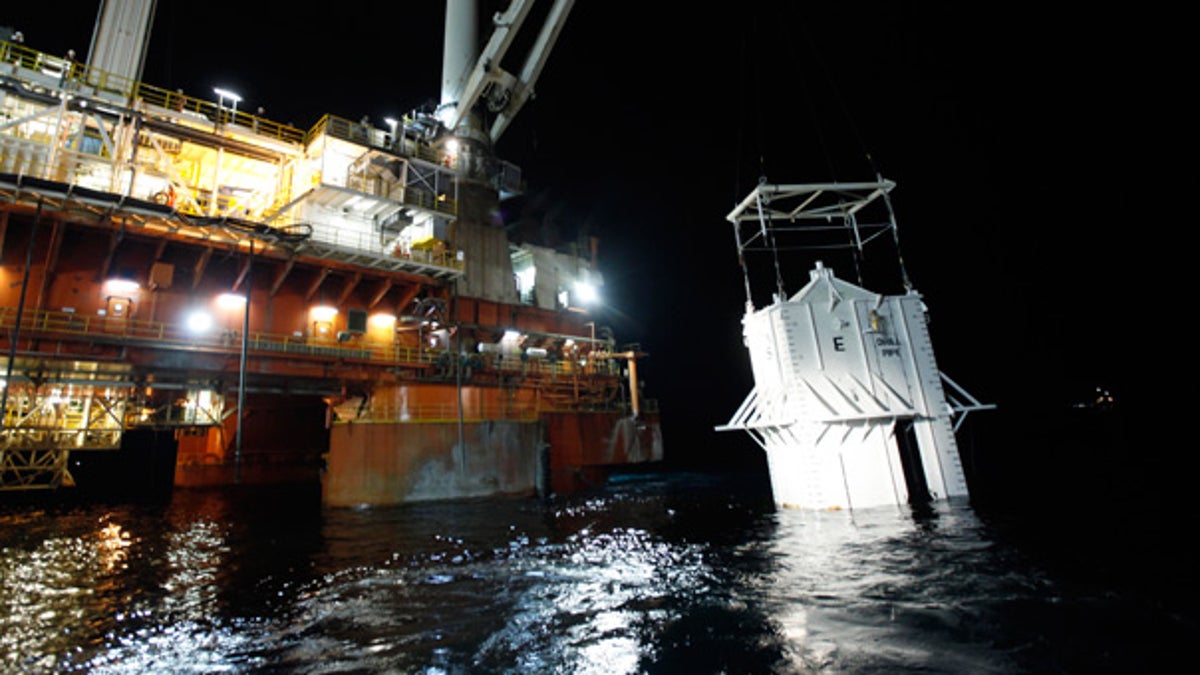
May 6: The oil containment box is lowered into the Gulf at the site of the Deepwater Horizon rig collapse. (AP)
ON THE GULF OF MEXICO -- A day after icy slush clogged the massive box they hoped would contain an out-of-control oil gusher in the Gulf of Mexico, BP officials on Sunday said they may try again -- this time with a smaller box.
They also were considering several other options to stop the daily rush of at least 200,000 gallons of crude, which began washing up on beaches in thick blobs over the weekend.
With crippled equipment littering the ocean floor, oil company engineers scrambled to devise a fresh method to cap the ruptured well. Their previous best hope for containing the leak quickly, a four-story containment box, became encrusted with deep-sea crystals Saturday and had to be cast aside.
Among the plans under consideration:
-- Deploying a new, smaller containment box in the hope that it would be less likely to get clogged. Officials said the new box could be in place by midweek.
"We're going to pursue the first option that's available to us and we think it'll be the top hat," the smaller box, BP Chief Operating Officer Doug Suttles said.
-- Cutting the riser pipe, which extends from the mile-deep well, undersea and using larger piping to bring the gushing oil to a drill ship on the surface, a tactic considered difficult and less desirable because it will increase the flow of oil.
-- Shooting mud and concrete directly into the well's blowout preventer, a device that was supposed to shut off the flow of oil after a deadly April 20 oil rig explosion but failed. The technique, known as a "top kill," is supposed to plug up the well and would take two to three weeks.
-- Try again using the containment box that failed to work Saturday after finding a way to keep the crystals from building up.
The engineers appear to be "trying anything people can think of" to stop the leak, said Ed Overton, a LSU professor of environmental studies.
"Hopefully these are low-risk type of operations," he said. "We don't want to do anything to make it flow more."
An estimated 3.5 million gallons of oil have spilled since the explosion. At that pace, the spill would surpass the 11 million gallons spilled in the Exxon Valdez disaster by next month. BP is drilling a relief well that is considered a permanent fix, but that will take several weeks to complete.
BP PLC spokesman Mark Proegler said no decisions have been made on what step the company will take next. A decision could come as early as Monday.
Philip Johnson, a petroleum engineering professor at the University of Alabama, said cutting the riser pipe and slipping a larger pipe over the cut end could conceivably divert the flow of oil to the surface.
"That's a very tempting option," he said. "The risk is when you cut the pipe, the flow is going to increase. ... That's a scary option, but there's still a reasonable chance they could pull this off."
Johnson was less optimistic that a smaller containment box would be less susceptible to being clogged by icelike crystals.
"My suspicion is that it's likely to freeze up anyway," he said. "But I think they should be trying everything they can."
There was a renewed sense of urgency as dime- to golfball-sized balls of tar washed up Saturday on Dauphin Island, three miles off the Alabama mainland at the mouth of Mobile Bay and much farther east than the thin, rainbow sheens that have arrived sporadically in the Louisiana marshes. Until Saturday none of the thick sludge -- those indelible images from the Valdez and other spills -- had reached shore.
Above the oil leak, waves of dark brown and black sludge crashed into the support ship Joe Griffin. The fumes there were so intense that a crewmember and an AP photographer on board had to wear respirators while on deck.
A white cattle egret landed on the ship, brownish-colored stains of oil on its face and along its chest, wings and tail.
The containment box plan, never before tried at such depths, had been designed to siphon up to 85 percent of the leaking oil to a tanker at the surface. It had taken about two weeks to build the box and three days to cart it 50 miles out and slowly lower it to the well.
Icelike hydrates, a slushy mixture of gas and water, clogged the opening in the top of the peaked box like sand in a funnel, only upside-down.
BP officials were not giving up hopes that a containment box -- either the one brought there or another one being built -- could cover the well. Crews planned Sunday to secure the box about 1,600 feet from the massive leak site, much farther away from where it was placed Saturday, according to a daily activity sheet reviewed by The Associated Press.
The April 20 blowout was triggered by a bubble of methane gas that escaped from the well and shot up the drill column, expanding quickly as it burst through several seals and barriers before exploding, according to interviews with rig workers conducted during BP's internal investigation. Deep sea oil drillers often encounter pockets of methane crystals as they dig into the earth.
As the bubble rose, it intensified and grew, breaking through various safety barriers, said Robert Bea, a University of California Berkley engineering professor and oil pipeline expert who detailed the interviews exclusively to an AP reporter.

